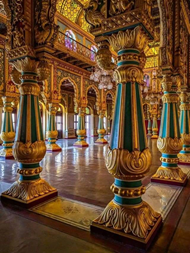Heritage Tourism - The LayMan's Perspective
Heritage Tourism - The LayMan's Perspective
Heritage & Tourism – The Lay-Man’s perspective
Keywords – Heritage, Tourism, perspective,
vision/eye/grasp of the commoner, literately illiterate, ecological &
economic friendly, interpretation, presentation of the Heritage.
Introduction
& Preamble
The festive season almost at its peak, like the Ganesh festival is almost over and Dusshera (Durga Pooja) is almost at the threshold of the beginning. The comeback of the josh, jallosh, scale & the enthusiasm of Ganesh Festival seemed to know no limits. Everyone wants to venture out, explore things, tangible, intangible, etc., with all these, there are new protocols, procedures, restrictions, new pattern of behavior, it was inevitable, after the long pandemic affect. People wanted and were waiting to come out from the virtual world (online) to the material/physical (offline) world.
Image 1 - Image 2
Ok..Ok…Ok…
Now, you might be thinking about the Blog… Yes,
coming back to the Topic, let us look at the terms – Heritage, Tourism, the Lay man, his perspective and the interrelation
with them. Because, before one starts, one should understand these terms
individually (literally) and the correlation with them.
Tourism: - A person travelling places for pleasure or
fun or with some for stress relief, away from one’s home of permanent place of
stay (as on in India). A person, who is involved in the hospitality
industry responsible for the management of services like mode of travel, mode
of accommodation, etc. for tourists. These days’ tourism has become more
subjective like Sustainable tourism, Food tourism, Experiential, tourism, Wellness
tourism and much more.
The Layman: - Here particularly, the term
“lay man” or the Visitor, refers to people from
all walks of life & livelihood, for e.g.: - School Children, College
Youth, Working Class, Old aged/retired, pilgrimage, leisure, etc., who want to
venture out, who want to seek a career or an entrepreneur, an experienced
traveler wanting to share & seek economic benefits, others who can comment
or interpret the Heritage according to their inception of thought. One can be illiterate or literate, but should
be able to think and draw a conclusion –
may be optimistic or pessimistic, circumstantial or personal. This blog
particularly targets the Layman as a Visitor, as any other role would require,
altogether a different blog or a series of blogs depending on the role of the
Visitor.
India’s built and cultural heritage is
unparalleled in the world. India has one of the largest and diversified
geographically, geological, ecological, political, and architectural heritage. Every
native region can be recognized globally as significant part of its unique
cultural identity.
Now, let us comprehensively look at all these
terms, i.e, Heritage Tourism & the Layman’s perspective
In the Indian Context it does differ
because, unlike other western nations, India’s
built and unbuilt heritage shows continuity, consistency, preservation of
centuries ‘old structures & customs, which are even practiced till date.
Hence, the lay man tries to interfere, interpret and starts connecting with the space, where he belongs to and where he
would visit to.
In this age of utmost globalization, options available and any information
available on the touch of a fingertip, the visitor has become more aware of
the places he is going to explore. Instant
booking, instant backpack tours, organized tours (travel companies) are the
various tools where everything can be predefined and risks can be avoided and
unnecessary Time and Cost can be avoided.
On the above all factors, the visitor,
depending on the purpose of the tour,
the entourage is finalized and off you go…
Mostly the destination or site seeing revolves around the built and unbuilt
heritage of the destination or some particular regional event to be attended.
Of course, one does not want to quantify
or qualify any target segment of visitors, but surely, heritage is an
integral part of the chosen destinations.
Now, that we have learned the Heritage
Tourism, let us now focus upon the perspective of the Layman… here, the
Visitor.
The Visitor of course, does a
preliminary study or finds out relevant information as just an onlooker, or from a particular background of expertise, he
is from. What he tends to miss is - Rational thinking or intellectual
(thoughtful) approach or maybe he is too judgmental, most of the times.
One feels that the perspective of the Layman... here the visitor should be improvised in terms of his perception about the importance, significance, how did the heritage come in to being, the effort put in to its very own existence today and for the future. The visitor should be made aware of the takeaways, learned lessons, etc.
These can be done in a number of ways,
like, the policies of visitors and for visitors should be more enforced in
terms of their takeaways. Projecting the cosmetic/superficiality of the place
can be avoided, and the real fabric of
the heritage should be exposed. The sustainable
viability, material, should be enthralled upon the visitor. Other factors like preservation of the
Space or culture through various governing bodies and conserving them through
repairs, rehabilitation, retrofitting, etc. are inevitable and are done impromptu,
but an important factor is presentation
of the space to the eye of the Visitor and through interventions inspired
by behavioral architecture is really very important. The reason should
have a strong impact on the visitor and an everlasting memory.
Image 11 Image 12
Thus,
this blog emphasizes on one of the parameters of the Lay man’s perspective as a
Visitor, i.e., interpretation and the opinion for the built & unbuilt
space, holistically as a Tourist.
In the next blog, one shall
concentrate on the role of an entrepreneur with respect to heritage &
tourism….
Image 1 – A Window (Old but exposes the
workmanship & the detailing, probably ignored by the visitor
Image 2 – Statue of Ganesha housing a building
(The scale leaves the visitor awestruck)
Image 3 – Interiors of a palace (Restored for
the visitor for a short visit, shows the level of restoration)
Image 4 – Interiors of a Sabha Mandap in a
temple (An image from FB, that lures the visitor)
Image 5 – An aerial view of the Kailashnatha
temple at Ellora (A visitor might find attractive)
Image 6 - A restored residence in Khotachi
wadi, Girgaun, Mumbai (Revival for the future)
Image 7 - A visitor in a temple premise (His
perception or thought process, one can imagine)
Image 8 Hira Baug (Madhavbaug, Mumbai)
presentation to the Visitor
Image 9 – Panchmukhi Hanuman (The visitor has
to remember him)
Image 10 – The sacred immersion (Looks not so
sacred after the rituals)
Image 11 – The Line of Tropic of Cancer passing
in a field near Bhopal (Not many visitors are aware of this geographic place)
Image 12 – Panchmukhi Shiva (leaves an
everlasting memory on the Visitor)
Written by :
Ar. Rajesh Parmar
Thakur School of Architecture & Planning
Eligibility Requirements for Admission to Architecture in India:
HSC in Science Stream, with 50% Aggregate and 50% Aggregate in PCM.
Qualifying Entrance Exam: NATA or JEE-Paper II
For any details contact us
E-mail: tsap@thakureducation.org
Contact: 022-67308001/02
Whatsapp: +91-9833665446
















Comments
Post a Comment